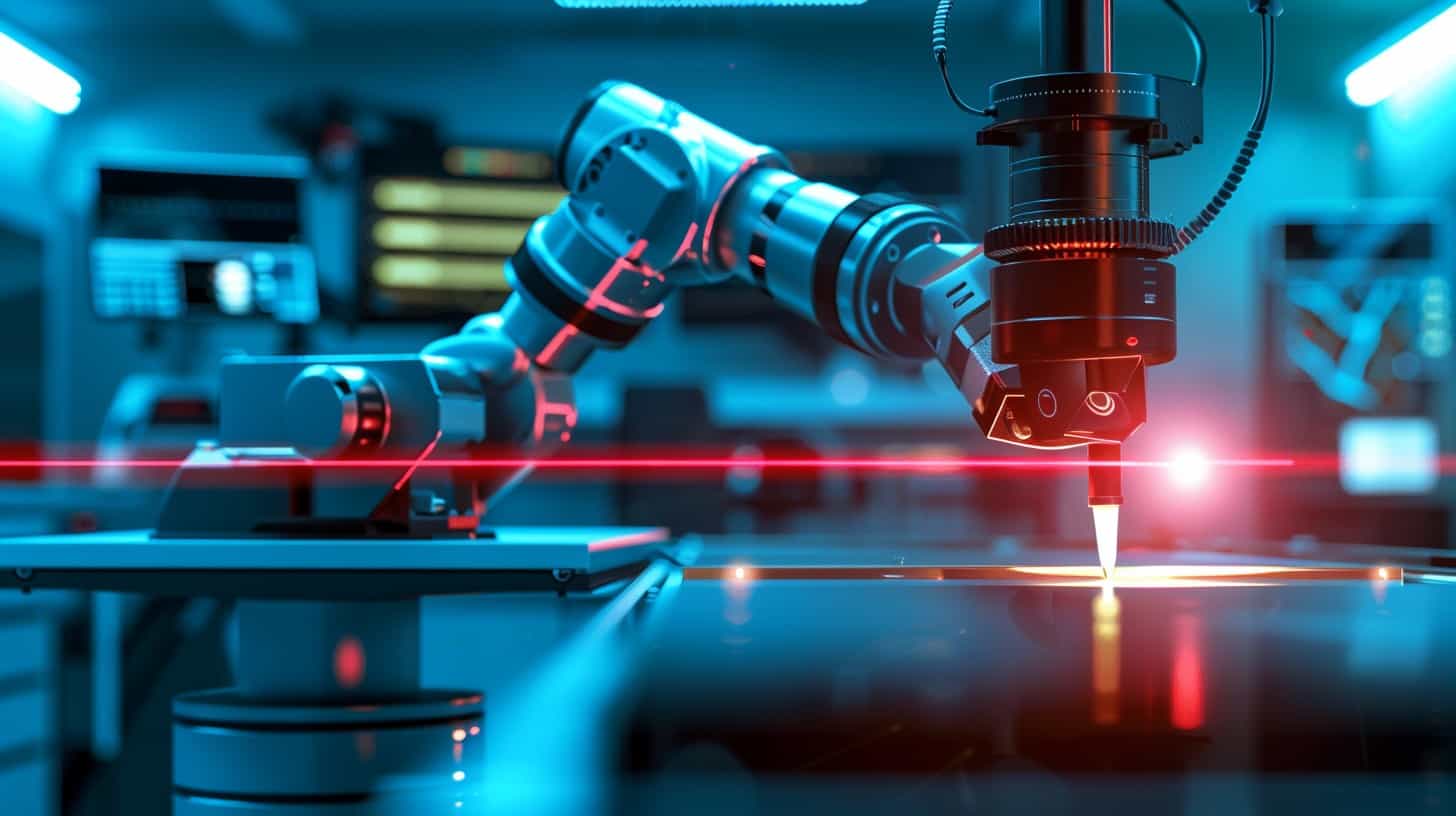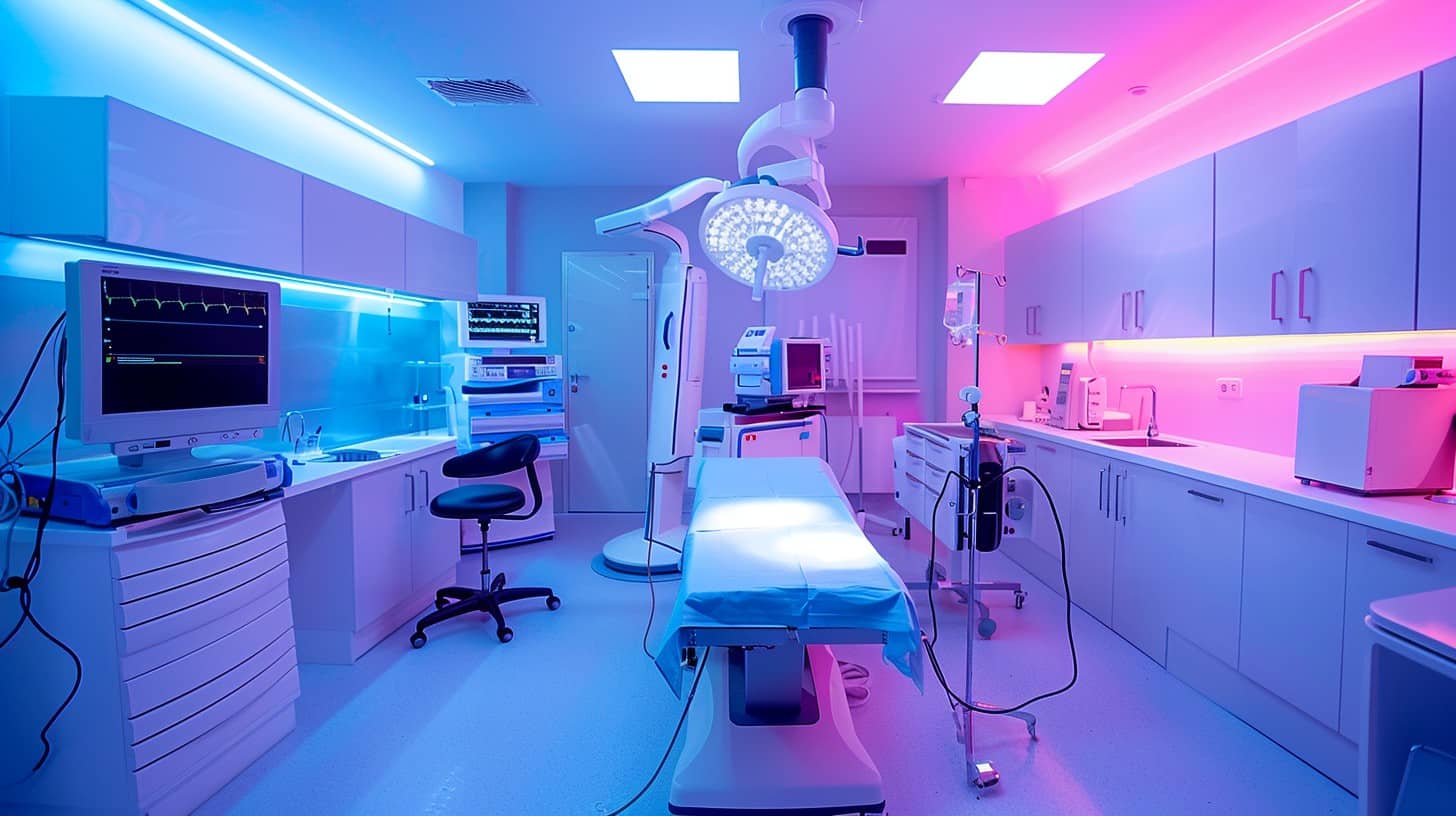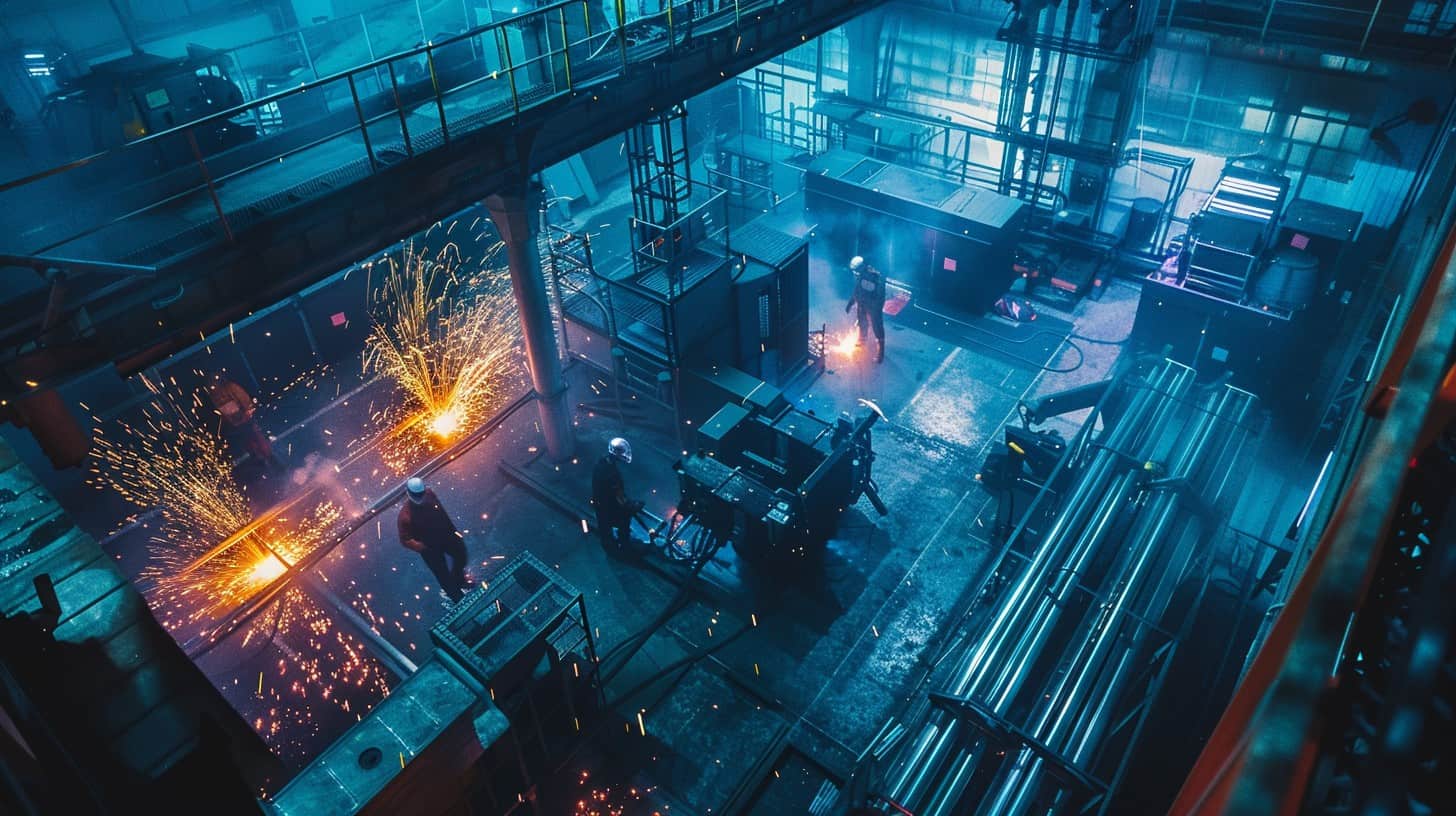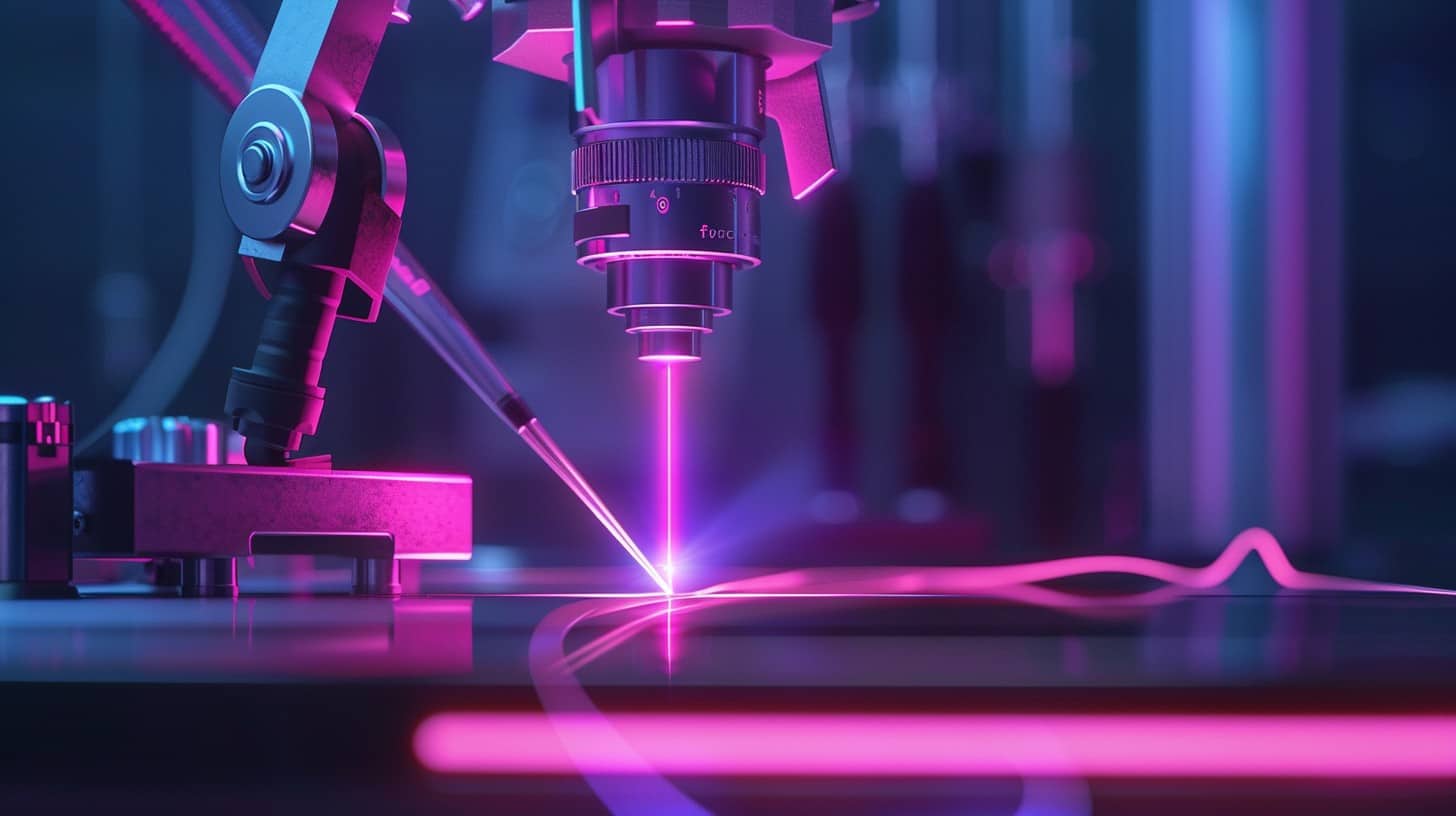Ever feel like technology is moving at the speed of light? Well, in the case of lasers, it literally is. These bright beams are everywhere – from checking out at the grocery store to breakthrough medical procedures.
Our article shines a light on seven ways lasers are changing our world… and why you should care. Get ready for an illuminating read!
Key Takeaways
Lasers help atomic clocks keep super accurate time, crucial for GPS and space exploration.
Doctors use lasers in surgeries to cut precisely and heal wounds faster.
In stores, barcode scanners use lasers to make checkouts quick and easy.
Lasers allow communication with spacecraft, making data transmission from far away fast.
Military uses lasers for accurate targeting and creating non-lethal disorientation tools.
Table of Contents
Brief Overview of Laser Technology

Moving on from our enthralling introduction, let’s zoom into the core of what makes lasers the superheroes of modern technology. Picture a world where light serves as a precision tool, not just for illuminating our rooms, but for shaping the very fabric of tech and medicine.
This is laser technology in a nutshell – an acronym that stands for Light Amplification by Stimulated Emission of Radiation.
At its heart, this tech hinges on firing beams so intense they can cut through metal or gentle enough to fix human eyesight without a hitch. Imagine particles of light (photons), all marching in unison like an incredibly disciplined army—this coherency transforms them into powerful tools across diverse fields ranging from military gadgets such as directed energy weapons and infrared countermeasures to life-saving medical treatments like laser eye surgery and dental procedures.
Lasers are behind the barcode scanners that speed up your checkout at the store, DVDs that store your favorite movies in crystal clarity, and optical discs ensuring data storage is both compact and reliable.
They’re key players in scientific breakthroughs too; processes like Raman spectroscopy and two-photon excitation microscopy rely heavily on these precise pulses of light to unravel mysteries at microscopic levels.
And let’s not forget their star role in entertainment – giving those concert lights that extra zing or adding realism to holographic displays. So you see, it’s not just about pointing a red dot; it’s about unlocking potential with each pulse.
Amazing Uses of Lasers

Lasers, those beams of light we can’t get enough of, are doing things you wouldn’t believe. From fixing our teeth to chatting with space probes millions of miles away, they’re real game-changers.
Atomic Clocks
Atomic clocks use lasers to wrangle atoms into a precise dance, setting the beat for technologies like GPS and space measurements. It’s kind of like using a super-focused flashlight to herd cats, but in this case, the “cats” are pesky atoms that need corralling for timekeeping on steroids.
Thanks to this laser magic, atomic clocks boast accuracy so spot-on, they won’t lose a second in millions of years.
These clocks don’t just help your phone find the nearest coffee shop with uncanny precision; they’re also VIPs behind the scenes at space agencies. Picture guiding spacecraft through the cosmos or ensuring satellites are where they need to be—atomic clocks are there, keeping everything ticking perfectly.
With tech from companies like Arroyo Instruments providing top-notch tools for these laser tasks, it’s clear we’ve come a long way from sundials and hourglasses.
Welding and Cutting
Switching gears from atomic clocks, lasers also shine in the world of welding and cutting. Factories use these beams to slice through metal like butter and join pieces with precision.
Imagine building a complex machine or a sleek car—lasers make it happen by cutting shapes accurately and welding parts without the mess.
In surgeries, doctors rely on lasers too. They cut through tissues smoothly and seal wounds quickly. Whether it’s fixing cars or healing people, lasers are the go-to tool. For those really into making things, having one of the best fiber-cutting laser machines in your makerspace is like holding a magic wand—ready to transform any project into reality.
Bar Code Scanners
After talking about welding and cutting, let’s shift gears to something we encounter almost daily: bar code scanners. These handy tools beam lasers to read barcodes at stores. This way, they keep track of inventory and check out prices swiftly.
Without them, lines would be a nightmare.
Bar code readers are real champs for shop owners and customers alike. They make shopping smooth by zapping codes on everything from cereal boxes to high-tech gadgets. Think of them as the unsung heroes in the checkout line – making our lives easier one scan at a time.
Planetary Communication
Moving from the simplicity of scanning your favorite snack’s barcode, let’s shoot for the stars—literally. Planetary communication takes laser tech to a whole new level. Imagine talking across the vast emptiness of space without having to wait forever for a reply.
Thanks to NASA’s Laser Communications Relay Demonstration, robots exploring distant worlds chat with us back on Earth like neighbors over a fence. It’s not just talk; they’re sending pictures, data, and maybe one day… selfies?
This isn’t just any old chit-chat. We’re talking high-speed data transmission that makes your home Wi-Fi look like snail mail. With lasers shooting through space, scientists get their hands on critical information faster than ever before.
Think about it: exploring Mars or keeping tabs on an asteroid becomes as easy as flipping through channels on your TV, thanks to these beams of light zipping through the cosmos. It’s all about making distance feel a bit less distant and turning science fiction into science fact—one laser pulse at a time.
Surveying
From chatting with robots in space, lasers take a sharp turn back to Earth with surveying. Lasers light the way for mapping our planet in incredible detail. Imagine zapping a laser beam from one point to another and capturing every little bump and dip along its path.
That’s exactly how laser scanning works, creating 3D maps of continents or even other planets.
This isn’t your grandpa’s map-making; it’s high-tech treasure hunting without the shovels. Engineers use devices like laser altimeters and GPS technology to measure distances down to the last millimeter.
These tools help us understand our world better, guiding everything from construction projects to environmental research. And yes, thanks to lasers, we can now say there’s a map for that — a very precise one.
Military Applications
Lasers in the military are like something out of a sci-fi movie, but way cooler because they’re real. Think laser weapons zapping enemy targets with pinpoint accuracy. These aren’t just any lasers; we’re talking high-tech gadgets that can disarm bombs from afar or light up targets to make sure our guys hit the bull’s-eye every time.
Plus, there’s this wild tech called holographic sights that turn regular soldiers into sharpshooters by helping them aim better.
Now, let’s get into the non-lethal stuff – because not every laser has to go “pew pew.” Some are all about disorienting the bad guys without hurting anyone. Imagine a blinding flash of light that says, “Please pause your evil plans,” giving our forces the upper hand without firing a shot.
And for those sneaky missions at night? Infrared laser sights come into play, turning darkness into an ally. These tools don’t just look cool hanging off a rifle; they give soldiers superhuman sight under cover of night.
So yeah, lasers in the military? They’re game-changers on and off the battlefield.
Medical Treatments
In the world of healthcare, doctors wield lasers like modern-day wizards. They use them for everything from zapping tumors to fixing eyesight with refractive eye surgery. Imagine lying back in a chair and, in a matter of minutes, saying goodbye to glasses thanks to laser technology.
Not just for the big stuff, lasers play a role in perfecting smiles too—dental work becomes less daunting with these beams of light making tooth whitening quick and easy.
But it’s not all about looking good; it’s also about feeling better. Lasers help heal by removing cancer cells and managing scars after surgery. Plus, they’re key players in photobiomodulation therapy—a fancy term for using light to relieve pain or inflammation.
So next time you hear “laser,” think beyond those sci-fi movies; think medicine advancing right before our eyes… Now let’s shift gears and see how lasers make their mark outside the hospital walls—in industrial and commercial settings.
The Role of Lasers in Industrial and Commercial Settings

Lasers play a big part in shaping the stuff around us, especially in factories and shops. They cut through metal like butter to create everything from car parts to computer chips. This isn’t just about brute strength, though.
Lasers bring precision that’s hard to beat, making sure every cut is clean and every detail spot-on. Imagine trying to do this with a saw – no thanks! Plus, they’re speedy, turning what used to take hours into minutes.
In stores, those little red beams scanning your snacks? Yep, lasers again. Barcode scanners zip across codes at lightning speed, keeping lines moving and avoiding the dreaded long wait at checkout.
Then there’s NASA using laser tech for zippy space chats, and the military spotting dangers from afar without breaking a sweat. Whether it’s crafting devices with diode-pumped solid-state technology or tagging items with barcode readers, lasers are everywhere in work and shopping spots.
Now let’s shine a light on how lasers add sparkle and thrills in entertainment and recreation next.
Laser Usage in Entertainment and Recreation

Shifting gears from the world of work to play, lasers light up our free time too. Imagine a concert without those mesmerizing beams dancing across the stage—sounds pretty dull, right? That’s where laser light shows come into play, turning music events into visual spectacles.
And it’s not just big events; even your local club might use lasers to add that wow factor to a Saturday night.
But let’s not forget about those lazy afternoons at home. Ever used a DVD player or played games on a Blu-ray console? You’ve got lasers to thank for that, too. These gadgets use laser technology to read data off discs, bringing movies and video games to life in your living room.
And if you’re into geeky hobbies, perhaps you’ve dabbled with holograms or even created your own using basic laser kits available for enthusiasts. Whether it’s for grand spectacle or everyday entertainment, lasers are there making sure fun times are just a bit more dazzling.
The Future Potential of Laser Technology
Laser technology is on a wild ride to the future, and we’re all strapped in for the journey. Imagine chatting with someone on Mars as easily as you text your friend down the street.
That’s where lasers can take us, offering space communication with bandwidths that make today’s internet speeds look like snail mail. Arroyo Instruments is leading the charge, crafting tools that control those powerful beams of light.
This isn’t sci-fi—it’s what tomorrow looks like.
Picture laser scanners sketching out new worlds in 3D, or soldiers spotting dangers from miles away without breaking a sweat. Lasers are about to transform how we explore planets and keep people safe.
With inventors and makerspaces buzzing around laser tech like bees around honey, who knows what’ll be next? Laser-powered skateboards? Maybe not yet—but never say never in a world where light does the heavy lifting.
FAQs About the Uses of Lasers
What makes lasers a big deal in tech and medicine?
Lasers are like the Swiss Army knives of technology and medicine. They cut, mend, scan, and even help things glow. From zapping away unwanted hair in cosmetic surgery to scanning barcodes at your local store, lasers are everywhere!
Can lasers really help doctors during surgeries?
Absolutely! Picture this: surgeons using laser beams as precise as a pencil tip to fix tiny parts inside your body without making big cuts. Lasers work wonders in oral care too, fixing teeth with the finesse of a fairy godmother.
How do scientists use lasers to look at tiny stuff?
Imagine shrinking down and going on a magic carpet ride over the land of the very small. That’s what scientists do with laser microscopy and confocal laser scanning microscopy. They get to see things up close that we can’t even imagine — all thanks to those mighty little beams.
Do lasers have any cool uses outside of science labs?
You bet! Ever watched a movie where the hero escapes by following a green dot from a laser pointer? Or noticed how cashiers scan your snacks so fast using barcode links? Lasers make our lives easier and more exciting than ever before.
How do lasers light up the night sky for pilots?
Pilots use something called infrared homing with seeker heads – think of it as playing tag with invisible light! And for those super-secret missions, they rely on night vision devices lit up by infrared lasers to see clear as day.
Are there any futuristic uses for lasers that seem straight out of sci-fi movies?
Get ready for this: scientists are working on using pulsed diode arrays in plasma acceleration for space travel – yes, like warp speed in space ships! Plus, they’re exploring ways to fold proteins with lasers in research that could change medicine forever.



